(All information courtesy of the instrument teams.)
![]() Previous IAU Circulars
Previous IAU Circulars
TITLE: GCN/INTEGRAL NOTICE
NOTICE_DATE: Wed 11 Jul 12 02:45:03 UT
NOTICE_TYPE: INTEGRAL Wakeup
TRIGGER_NUM: 6599, Sub_Num: 0
GRB_RA: 94.7055d {+06h 18m 49s} (J2000),
94.6639d {+06h 18m 39s} (current),
94.8707d {+06h 19m 29s} (1950)
GRB_DEC: -71.0124d {-71d 00' 44"} (J2000),
-71.0181d {-71d 01' 04"} (current),
-70.9892d {-70d 59' 20"} (1950)
GRB_ERROR: 3.12 [arcmin, radius, statistical only]
GRB_INTEN: 9.32 [sigma]
GRB_TIME: 9895.29 SOD {02:44:55.29} UT
GRB_DATE: 16119 TJD; 193 DOY; 12/07/11
SC_RA: 64.84 [deg] (J2000)
SC_DEC: -71.14 [deg] (J2000)
SUN_POSTN: 110.80d {+07h 23m 11s} +22.06d {+22d 03' 39"}
SUN_DIST: 93.76 [deg] Sun_angle= 1.1 [hr] (West of Sun)
MOON_POSTN: 16.83d {+01h 07m 20s} +11.11d {+11d 06' 51"}
MOON_DIST: 96.60 [deg]
GAL_COORDS: 281.50,-28.18 [deg] galactic lon,lat of the burst
ECL_COORDS: 251.25,-85.24 [deg] ecliptic lon,lat of the burst
COMMENTS: INTEGRAL GRB Coordinates.
COMMENTS: Time_Scale=0.1599 and Time_Error=2.0000.
COMMENTS:
COMMENTS: NOTE: This INTEGRAL event is temporally(2.0<100sec) coincident with the FERMI_GBM event (trignum=363667496).
COMMENTS: Possibly real GRB event
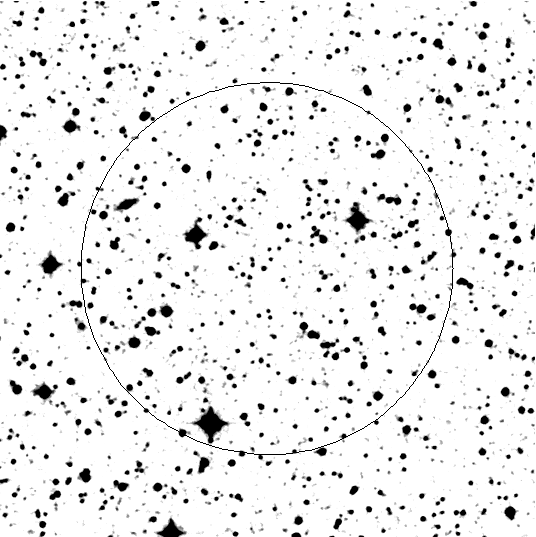
TITLE: GCN/INTEGRAL NOTICE
NOTICE_DATE: Wed 11 Jul 12 02:46:05 UT
NOTICE_TYPE: INTEGRAL Refined
TRIGGER_NUM: 6599, Sub_Num: 1
GRB_RA: 94.6898d {+06h 18m 46s} (J2000),
94.6484d {+06h 18m 36s} (current),
94.8545d {+06h 19m 25s} (1950)
GRB_DEC: -71.0002d {-71d 00' 00"} (J2000),
-71.0059d {-71d 00' 20"} (current),
-70.9771d {-70d 58' 36"} (1950)
GRB_ERROR: 2.62 [arcmin, radius, statistical only]
GRB_INTEN: 21.88 [sigma]
GRB_TIME: 9959.60 SOD {02:45:59.60} UT
GRB_DATE: 16119 TJD; 193 DOY; 12/07/11
SC_RA: 64.84 [deg] (J2000)
SC_DEC: -71.14 [deg] (J2000)
SUN_POSTN: 110.80d {+07h 23m 11s} +22.06d {+22d 03' 39"}
SUN_DIST: 93.75 [deg] Sun_angle= 1.1 [hr] (West of Sun)
MOON_POSTN: 16.84d {+01h 07m 22s} +11.12d {+11d 07' 01"}
MOON_DIST: 96.60 [deg]
GAL_COORDS: 281.49,-28.18 [deg] galactic lon,lat of the burst
ECL_COORDS: 251.25,-85.25 [deg] ecliptic lon,lat of the burst
COMMENTS: INTEGRAL GRB Coordinates.
COMMENTS: Time_Scale=10.0000 and Time_Error=10.0000.
COMMENTS:
COMMENTS: NOTE: This INTEGRAL event is temporally(66.0<100sec) coincident with the FERMI_GBM event (trignum=363667496).
COMMENTS: Possibly real GRB event
TITLE: GCN/FERMI NOTICE
NOTICE_DATE: Wed 11 Jul 12 02:45:23 UT
NOTICE_TYPE: Fermi-GBM Flight Position
RECORD_NUM: 45
TRIGGER_NUM: 363667496
GRB_RA: 69.633d {+04h 38m 32s} (J2000),
69.666d {+04h 38m 40s} (current),
69.503d {+04h 38m 01s} (1950)
GRB_DEC: -62.883d {-62d 52' 59"} (J2000),
-62.859d {-62d 51' 32"} (current),
-62.980d {-62d 58' 49"} (1950)
GRB_ERROR: 8.45 [deg radius, statistical plus systematic]
GRB_INTEN: 270 [cnts/sec]
DATA_SIGNIF: 7.20 [sigma]
INTEG_TIME: 2.048 [sec]
GRB_DATE: 16119 TJD; 193 DOY; 12/07/11
GRB_TIME: 9893.29 SOD {02:44:53.29} UT
GRB_PHI: 70.00 [deg]
GRB_THETA: 145.00 [deg]
DATA_TIME_SCALE: 2.0480 [sec]
HARD_RATIO: 0.49
LOC_ALGORITHM: 3 (version number of)
MOST_LIKELY: 95% GRB
2nd_MOST_LIKELY: 4% Generic Transient
DETECTORS: 0,0,1, 0,0,0, 0,1,0, 0,0,0, 0,0,
SUN_POSTN: 110.80d {+07h 23m 11s} +22.06d {+22d 03' 39"}
SUN_DIST: 90.90 [deg] Sun_angle= 2.7 [hr] (West of Sun)
MOON_POSTN: 16.83d {+01h 07m 20s} +11.11d {+11d 06' 54"}
MOON_DIST: 84.32 [deg]
MOON_ILLUM: 50 [%]
GAL_COORDS: 273.59,-38.91 [deg] galactic lon,lat of the burst (or transient)
ECL_COORDS: 13.47,-80.61 [deg] ecliptic lon,lat of the burst (or transient)
COMMENTS: Fermi-GBM Flight-calculated Coordinates.
COMMENTS: This trigger occurred at longitude,latitude = 203.43,-1.68 [deg].
COMMENTS:
COMMENTS: NOTE: This GBM event is temporally(2.0<100sec) coincident with the INTEGRAL event (trignum=6599).
TITLE: GCN/FERMI NOTICE
NOTICE_DATE: Wed 11 Jul 12 02:45:28 UT
NOTICE_TYPE: Fermi-GBM Flight Position
RECORD_NUM: 57
TRIGGER_NUM: 363667496
GRB_RA: 65.733d {+04h 22m 56s} (J2000),
65.739d {+04h 22m 57s} (current),
65.713d {+04h 22m 51s} (1950)
GRB_DEC: -67.700d {-67d 42' 00"} (J2000),
-67.671d {-67d 40' 16"} (current),
-67.814d {-67d 48' 51"} (1950)
GRB_ERROR: 7.90 [deg radius, statistical plus systematic]
GRB_INTEN: 241 [cnts/sec]
DATA_SIGNIF: 11.00 [sigma]
INTEG_TIME: 4.096 [sec]
GRB_DATE: 16119 TJD; 193 DOY; 12/07/11
GRB_TIME: 9893.29 SOD {02:44:53.29} UT
GRB_PHI: 79.00 [deg]
GRB_THETA: 145.00 [deg]
DATA_TIME_SCALE: 4.0960 [sec]
HARD_RATIO: 0.54
LOC_ALGORITHM: 3 (version number of)
MOST_LIKELY: 95% GRB
2nd_MOST_LIKELY: 4% Generic Transient
DETECTORS: 0,0,1, 0,0,0, 0,1,0, 0,0,0, 0,0,
SUN_POSTN: 110.80d {+07h 23m 11s} +22.06d {+22d 03' 39"}
SUN_DIST: 95.66 [deg] Sun_angle= 3.0 [hr] (West of Sun)
MOON_POSTN: 16.84d {+01h 07m 20s} +11.12d {+11d 06' 55"}
MOON_DIST: 86.17 [deg]
MOON_ILLUM: 50 [%]
GAL_COORDS: 280.11,-38.73 [deg] galactic lon,lat of the burst (or transient)
ECL_COORDS: 342.01,-80.56 [deg] ecliptic lon,lat of the burst (or transient)
COMMENTS: Fermi-GBM Flight-calculated Coordinates.
COMMENTS: This trigger occurred at longitude,latitude = 203.43,-1.68 [deg].
COMMENTS:
COMMENTS: NOTE: This GBM event is temporally(2.0<100sec) coincident with the INTEGRAL event (trignum=6599).
TITLE: GCN/FERMI NOTICE
NOTICE_DATE: Wed 11 Jul 12 02:46:34 UT
NOTICE_TYPE: Fermi-GBM Flight Position
RECORD_NUM: 120
TRIGGER_NUM: 363667496
GRB_RA: 56.483d {+03h 45m 56s} (J2000),
56.526d {+03h 46m 06s} (current),
56.313d {+03h 45m 15s} (1950)
GRB_DEC: -63.683d {-63d 40' 59"} (J2000),
-63.645d {-63d 38' 40"} (current),
-63.837d {-63d 50' 14"} (1950)
GRB_ERROR: 5.68 [deg radius, statistical plus systematic]
GRB_INTEN: 511 [cnts/sec]
DATA_SIGNIF: 21.00 [sigma]
INTEG_TIME: 4.096 [sec]
GRB_DATE: 16119 TJD; 193 DOY; 12/07/11
GRB_TIME: 9893.29 SOD {02:44:53.29} UT
GRB_PHI: 80.00 [deg]
GRB_THETA: 150.00 [deg]
DATA_TIME_SCALE: 4.0960 [sec]
HARD_RATIO: 0.55
LOC_ALGORITHM: 3 (version number of)
MOST_LIKELY: 95% GRB
2nd_MOST_LIKELY: 4% Generic Transient
DETECTORS: 0,0,1, 0,0,0, 0,1,0, 0,0,0, 0,0,
SUN_POSTN: 110.80d {+07h 23m 11s} +22.06d {+22d 03' 39"}
SUN_DIST: 95.53 [deg] Sun_angle= 3.6 [hr] (West of Sun)
MOON_POSTN: 16.84d {+01h 07m 23s} +11.12d {+11d 07' 05"}
MOON_DIST: 80.65 [deg]
MOON_ILLUM: 50 [%]
GAL_COORDS: 277.78,-43.97 [deg] galactic lon,lat of the burst (or transient)
ECL_COORDS: 355.93,-75.79 [deg] ecliptic lon,lat of the burst (or transient)
COMMENTS: Fermi-GBM Flight-calculated Coordinates.
COMMENTS: This trigger occurred at longitude,latitude = 203.43,-1.68 [deg].
COMMENTS:
COMMENTS: NOTE: This GBM event is temporally(2.0<100sec) coincident with the INTEGRAL event (trignum=6599).
TITLE: GCN/FERMI NOTICE
NOTICE_DATE: Wed 11 Jul 12 02:46:36 UT
NOTICE_TYPE: Fermi-GBM Flight Position
RECORD_NUM: 124
TRIGGER_NUM: 363667496
GRB_RA: 56.717d {+03h 46m 52s} (J2000),
56.760d {+03h 47m 02s} (current),
56.544d {+03h 46m 11s} (1950)
GRB_DEC: -63.500d {-63d 30' 00"} (J2000),
-63.462d {-63d 27' 41"} (current),
-63.653d {-63d 39' 10"} (1950)
GRB_ERROR: 3.80 [deg radius, statistical plus systematic]
GRB_INTEN: 1874 [cnts/sec]
DATA_SIGNIF: 78.00 [sigma]
INTEG_TIME: 4.096 [sec]
GRB_DATE: 16119 TJD; 193 DOY; 12/07/11
GRB_TIME: 9893.29 SOD {02:44:53.29} UT
GRB_PHI: 80.00 [deg]
GRB_THETA: 150.00 [deg]
DATA_TIME_SCALE: 4.0960 [sec]
HARD_RATIO: 0.51
LOC_ALGORITHM: 3 (version number of)
MOST_LIKELY: 95% GRB
2nd_MOST_LIKELY: 4% Generic Transient
DETECTORS: 0,0,1, 0,0,0, 0,1,0, 0,0,0, 0,0,
SUN_POSTN: 110.80d {+07h 23m 11s} +22.06d {+22d 03' 39"}
SUN_DIST: 95.33 [deg] Sun_angle= 3.6 [hr] (West of Sun)
MOON_POSTN: 16.84d {+01h 07m 23s} +11.12d {+11d 07' 06"}
MOON_DIST: 80.58 [deg]
MOON_ILLUM: 50 [%]
GAL_COORDS: 277.49,-43.98 [deg] galactic lon,lat of the burst (or transient)
ECL_COORDS: 356.78,-75.80 [deg] ecliptic lon,lat of the burst (or transient)
COMMENTS: Fermi-GBM Flight-calculated Coordinates.
COMMENTS: This trigger occurred at longitude,latitude = 203.43,-1.68 [deg].
COMMENTS:
COMMENTS: NOTE: This GBM event is temporally(2.0<100sec) coincident with the INTEGRAL event (trignum=6599).
TITLE: GCN/FERMI NOTICE
NOTICE_DATE: Wed 11 Jul 12 02:47:06 UT
NOTICE_TYPE: Fermi-GBM Ground Position
RECORD_NUM: 56
TRIGGER_NUM: 363667496
GRB_RA: 79.920d {+05h 19m 41s} (J2000),
79.921d {+05h 19m 41s} (current),
79.918d {+05h 19m 40s} (1950)
GRB_DEC: -66.750d {-66d 45' 00"} (J2000),
-66.738d {-66d 44' 15"} (current),
-66.799d {-66d 47' 54"} (1950)
GRB_ERROR: 2.92 [deg radius, statistical only]
DATA_SIGNIF: 13.50 [sigma]
DATA_INTERVAL: 4.096 [sec]
GRB_DATE: 16119 TJD; 193 DOY; 12/07/11
GRB_TIME: 9893.29 SOD {02:44:53.29} UT
GRB_PHI: 75.00 [deg]
GRB_THETA: 140.00 [deg]
E_RANGE: 44.032 - 279.965 [keV]
LOC_ALGORITHM: 4143 (Gnd S/W Version number)
SUN_POSTN: 110.80d {+07h 23m 11s} +22.06d {+22d 03' 39"}
SUN_DIST: 91.77 [deg] Sun_angle= 2.1 [hr] (West of Sun)
MOON_POSTN: 16.85d {+01h 07m 24s} +11.12d {+11d 07' 10"}
MOON_DIST: 90.10 [deg]
MOON_ILLUM: 50 [%]
GAL_COORDS: 277.00,-33.77 [deg] galactic lon,lat of the burst (or transient)
ECL_COORDS: 352.66,-86.01 [deg] ecliptic lon,lat of the burst (or transient)
COMMENTS: Fermi-GBM Ground-calculated Coordinates.
COMMENTS: This Notice was ground-generated -- not flight-generated.
COMMENTS:
COMMENTS: NOTE: This GBM event is temporally(2.0<100sec) coincident with the INTEGRAL event (trignum=6599).
TITLE: GCN/FERMI NOTICE
NOTICE_DATE: Wed 11 Jul 12 02:48:45 UT
NOTICE_TYPE: Fermi-GBM Ground Position
RECORD_NUM: 119
TRIGGER_NUM: 363667496
GRB_RA: 169.830d {+11h 19m 19s} (J2000),
169.959d {+11h 19m 50s} (current),
169.317d {+11h 17m 16s} (1950)
GRB_DEC: -68.530d {-68d 31' 47"} (J2000),
-68.599d {-68d 35' 54"} (current),
-68.256d {-68d 15' 21"} (1950)
GRB_ERROR: 3.23 [deg radius, statistical only]
DATA_SIGNIF: 16.10 [sigma]
DATA_INTERVAL: 1.024 [sec]
GRB_DATE: 16119 TJD; 193 DOY; 12/07/11
GRB_TIME: 9893.29 SOD {02:44:53.29} UT
GRB_PHI: 96.00 [deg]
GRB_THETA: 112.00 [deg]
E_RANGE: 44.032 - 279.965 [keV]
LOC_ALGORITHM: 4143 (Gnd S/W Version number)
SUN_POSTN: 110.80d {+07h 23m 12s} +22.06d {+22d 03' 38"}
SUN_DIST: 100.16 [deg] Sun_angle= -3.9 [hr] (East of Sun)
MOON_POSTN: 16.86d {+01h 07m 27s} +11.12d {+11d 07' 26"}
MOON_DIST: 119.93 [deg]
MOON_ILLUM: 50 [%]
GAL_COORDS: 294.63, -7.16 [deg] galactic lon,lat of the burst (or transient)
ECL_COORDS: 220.79,-61.59 [deg] ecliptic lon,lat of the burst (or transient)
COMMENTS: Fermi-GBM Ground-calculated Coordinates.
COMMENTS: Bright hard burst in the GBM.
COMMENTS: This Notice was ground-generated -- not flight-generated.
COMMENTS:
COMMENTS: NOTE: This GBM event is temporally(72.0<100sec) coincident with the INTEGRAL_SPIACS event (trignum=6599).
TITLE: GCN/FERMI NOTICE
NOTICE_DATE: Wed 11 Jul 12 02:48:50 UT
NOTICE_TYPE: Fermi-GBM Ground Position
RECORD_NUM: 122
TRIGGER_NUM: 363667496
GRB_RA: 77.180d {+05h 08m 43s} (J2000),
77.186d {+05h 08m 45s} (current),
77.158d {+05h 08m 38s} (1950)
GRB_DEC: -66.290d {-66d 17' 23"} (J2000),
-66.275d {-66d 16' 27"} (current),
-66.352d {-66d 21' 06"} (1950)
GRB_ERROR: 1.12 [deg radius, statistical only]
DATA_SIGNIF: 74.40 [sigma]
DATA_INTERVAL: 4.096 [sec]
GRB_DATE: 16119 TJD; 193 DOY; 12/07/11
GRB_TIME: 9893.29 SOD {02:44:53.29} UT
GRB_PHI: 78.00 [deg]
GRB_THETA: 141.00 [deg]
E_RANGE: 44.032 - 279.965 [keV]
LOC_ALGORITHM: 4143 (Gnd S/W Version number)
SUN_POSTN: 110.80d {+07h 23m 12s} +22.06d {+22d 03' 38"}
SUN_DIST: 91.91 [deg] Sun_angle= 2.2 [hr] (West of Sun)
MOON_POSTN: 16.86d {+01h 07m 27s} +11.12d {+11d 07' 27"}
MOON_DIST: 88.92 [deg]
MOON_ILLUM: 50 [%]
GAL_COORDS: 276.70,-34.93 [deg] galactic lon,lat of the burst (or transient)
ECL_COORDS: 357.13,-84.87 [deg] ecliptic lon,lat of the burst (or transient)
COMMENTS: Fermi-GBM Ground-calculated Coordinates.
COMMENTS: Bright hard burst in the GBM.
COMMENTS: This Notice was ground-generated -- not flight-generated.
COMMENTS:
COMMENTS: NOTE: This GBM event is temporally(72.0<100sec) coincident with the INTEGRAL_SPIACS event (trignum=6599).
TITLE: GCN/INTEGRAL NOTICE
NOTICE_DATE: Wed 11 Jul 12 02:47:11 UT
NOTICE_TYPE: INTEGRAL SPI ACS Trigger
TRIGGER_NUM: 6599, Sub_Num: 0
GRB_INTEN: 21.62 [sigma]
GRB_TIME: 9965.25 SOD {02:46:05.25} UT
GRB_DATE: 16119 TJD; 193 DOY; 12/07/11
COMMENTS: INTEGRAL SPI_ACS GRB Trigger.
COMMENTS: Time_Scale=0.4000 and Time_Error=0.2000.
COMMENTS:
COMMENTS: NOTE: This SPIACS event is temporally(72.0<100sec) coincident with the FERMI_GBM event (trignum=363667496).
COMMENTS:
COMMENTS: The SPIACS lightcurve can be found at:
COMMENTS: ftp://isdcarc.unige.ch/arc/FTP/ibas/spiacs/2012-07/2012-07-11T02-46-05.1415-31363-39824-0.lc
TITLE: GCN/INTEGRAL NOTICE
NOTICE_DATE: Wed 11 Jul 12 02:48:03 UT
NOTICE_TYPE: INTEGRAL Refined
TRIGGER_NUM: 6599, Sub_Num: 2
GRB_RA: 94.6872d {+06h 18m 45s} (J2000),
94.6458d {+06h 18m 35s} (current),
94.8520d {+06h 19m 24s} (1950)
GRB_DEC: -71.0012d {-71d 00' 03"} (J2000),
-71.0069d {-71d 00' 24"} (current),
-70.9781d {-70d 58' 40"} (1950)
GRB_ERROR: 2.57 [arcmin, radius, statistical only]
GRB_INTEN: 27.43 [sigma]
GRB_TIME: 9990.60 SOD {02:46:30.60} UT
GRB_DATE: 16119 TJD; 193 DOY; 12/07/11
SC_RA: 64.84 [deg] (J2000)
SC_DEC: -71.14 [deg] (J2000)
SUN_POSTN: 110.80d {+07h 23m 11s} +22.06d {+22d 03' 38"}
SUN_DIST: 93.75 [deg] Sun_angle= 1.1 [hr] (West of Sun)
MOON_POSTN: 16.86d {+01h 07m 25s} +11.12d {+11d 07' 20"}
MOON_DIST: 96.60 [deg]
GAL_COORDS: 281.49,-28.19 [deg] galactic lon,lat of the burst
ECL_COORDS: 251.26,-85.25 [deg] ecliptic lon,lat of the burst
COMMENTS: INTEGRAL GRB Coordinates.
COMMENTS: Time_Scale=40.0000 and Time_Error=40.0000.
COMMENTS:
COMMENTS: NOTE: This INTEGRAL event is temporally(97.0<100sec) coincident with the FERMI_GBM event (trignum=363667496).
COMMENTS: Possibly real GRB event
Time Tel Filt Mag 1sigERR 112 P4 R 12.117 0.008 113 P1 V 12.593 0.014 116 P3 B 14.061 0.014The post-peak temporal index is estimated to be -2.1, suggesting a reverse shock.
TITLE: GCN/INTEGRAL NOTICE
NOTICE_DATE: Wed 11 Jul 12 04:08:25 UT
NOTICE_TYPE: INTEGRAL Offline
TRIGGER_NUM: 6599, Sub_Num: 3
GRB_RA: 94.7026d {+06h 18m 49s} (J2000),
94.6612d {+06h 18m 39s} (current),
94.8673d {+06h 19m 28s} (1950)
GRB_DEC: -71.0010d {-71d 00' 03"} (J2000),
-71.0067d {-71d 00' 23"} (current),
-70.9778d {-70d 58' 39"} (1950)
GRB_ERROR: 1.10 [arcmin, radius, statistical only]
GRB_INTEN: 27.43 [sigma]
GRB_TIME: 9990.60 SOD {02:46:30.60} UT
GRB_DATE: 16119 TJD; 193 DOY; 12/07/11
SC_RA: 64.84 [deg] (J2000)
SC_DEC: -71.14 [deg] (J2000)
SUN_POSTN: 110.85d {+07h 23m 25s} +22.05d {+22d 03' 11"}
SUN_DIST: 93.75 [deg] Sun_angle= 1.1 [hr] (West of Sun)
MOON_POSTN: 17.50d {+01h 10m 01s} +11.34d {+11d 20' 14"}
MOON_DIST: 96.60 [deg]
GAL_COORDS: 281.49,-28.18 [deg] galactic lon,lat of the burst
ECL_COORDS: 251.21,-85.25 [deg] ecliptic lon,lat of the burst
COMMENTS: INTEGRAL GRB Coordinates.
COMMENTS: Time_Scale=40.0000 and Time_Error=40.0000.
COMMENTS:
COMMENTS: NOTE: This INTEGRAL event is temporally(97.0<100sec) coincident with the FERMI_GBM event (trignum=363667496).
COMMENTS: refined_coordinates_after_offline_analysis
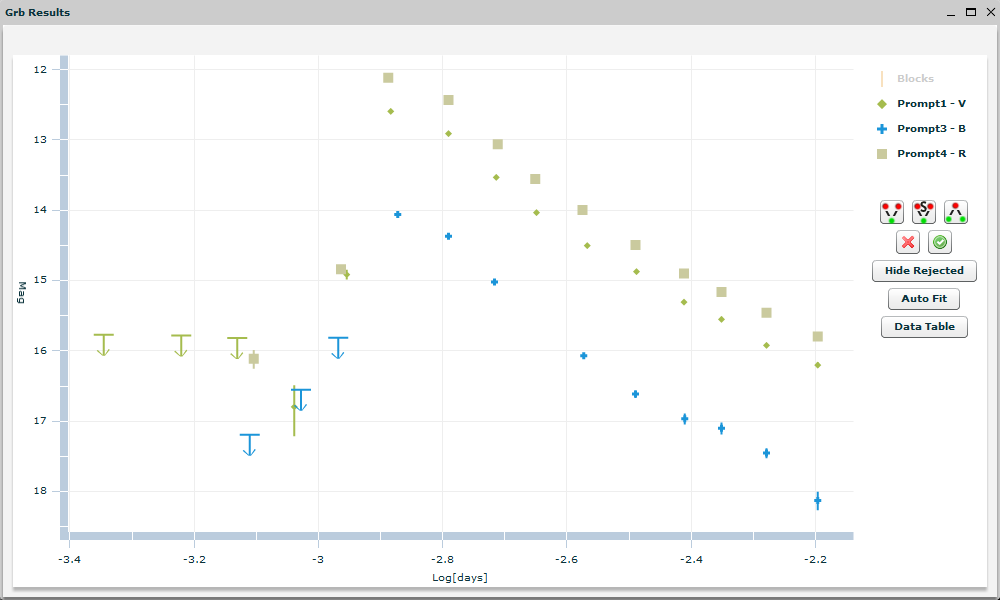
RA: 94.703 [degrees] DEC: -71.001 [degrees]with an uncertainty of 1.1 arc min (90% c.l.).
TITLE: GCN/SWIFT NOTICE
NOTICE_DATE: Wed 11 Jul 12 09:28:00 UT
NOTICE_TYPE: Swift-XRT Image
TRIGGER_NUM: 526283, Seg_Num: 0
GRB_RA: 270.2852d {+18h 01m 08.4s} (J2000),
270.4783d {+18h 01m 54.7s} (current),
269.5144d {+17h 58m 03.4s} (1950)
GRB_DEC: -25.0783d {-25d 04' 41.8"} (J2000),
-25.0778d {-25d 04' 40.2"} (current),
-25.0778d {-25d 04' 40.1"} (1950)
GRB_ERROR: 4.7 [arcsec, radius, statistical plus systematic]
GRB_INTEN: 254 [cnts]
IMG_START_DATE: 16119 TJD; 193 DOY; 12/07/11
IMG_START_TIME: 34030.87 SOD {09:27:10.87} UT, 488.3 [sec] since BAT Trigger Time
CENTROID_X: 289.25, raw= 289 [pixels]
CENTROID_Y: 263.31, raw= 263 [pixels]
ROLL: 265.13 [deg]
GAIN: 4
MODE: 3, Long Image mode
WAVEFORM: 134
EXPO_TIME: 2.50 [sec]
GRB_POS_XRT_Y: -81.77
GRB_POS_XRT_Z: -34.05
IMAGE_URL: sw00526283000msxps_rw.img
SUN_POSTN: 111.08d {+07h 24m 19s} +22.02d {+22d 01' 23"}
SUN_DIST: 160.89 [deg] Sun_angle= -10.6 [hr] (East of Sun)
MOON_POSTN: 20.08d {+01h 20m 19s} +12.18d {+12d 10' 34"}
MOON_DIST: 112.73 [deg]
MOON_ILLUM: 47 [%]
GAL_COORDS: 5.08, -1.02 [deg] galactic lon,lat of the burst
ECL_COORDS: 270.26, -1.64 [deg] ecliptic lon,lat of the burst
COMMENTS: SWIFT-XRT Image.
COMMENTS: The object found at this position is either a very bright burst or a cosmic ray hit.
COMMENTS: Examine the XRT Image to differentiate (CRs are much more compact); see examples at:
COMMENTS: http://www.swift.psu.edu/xrt/XRT_Postage_Stamp_Image_Photo_Gallery.htm .

TITLE: GCN/SWIFT NOTICE
NOTICE_DATE: Wed 11 Jul 12 09:28:10 UT
NOTICE_TYPE: Swift-XRT Processed Image
TRIGGER_NUM: 526283, Seg_Num: 0
GRB_RA: 270.2852d {+18h 01m 08.4s} (J2000),
270.4783d {+18h 01m 54.7s} (current),
269.5144d {+17h 58m 03.4s} (1950)
GRB_DEC: -25.0783d {-25d 04' 41.8"} (J2000),
-25.0778d {-25d 04' 40.2"} (current),
-25.0778d {-25d 04' 40.1"} (1950)
GRB_ERROR: 4.7 [arcsec, radius, statistical plus systematic]
GRB_INTEN: 254 [cnts]
IMG_START_DATE: 16119 TJD; 193 DOY; 12/07/11
IMG_START_TIME: 34030.87 SOD {09:27:10.87} UT, 488.3 [sec] since BAT Trigger Time
CENTROID_X: 289.25, raw= 289 [pixels]
CENTROID_Y: 263.31, raw= 263 [pixels]
ROLL: 265.13 [deg]
GAIN: 4
MODE: 3, Long Image mode
WAVEFORM: 134
EXPO_TIME: 2.50 [sec]
GRB_POS_XRT_Y: -81.77
GRB_POS_XRT_Z: -34.05
IMAGE_URL: sw00526283000msxps_rw.img
SUN_POSTN: 111.08d {+07h 24m 19s} +22.02d {+22d 01' 23"}
SUN_DIST: 160.89 [deg] Sun_angle= -10.6 [hr] (East of Sun)
MOON_POSTN: 20.08d {+01h 20m 20s} +12.18d {+12d 10' 36"}
MOON_DIST: 112.73 [deg]
MOON_ILLUM: 47 [%]
GAL_COORDS: 5.08, -1.02 [deg] galactic lon,lat of the burst
ECL_COORDS: 270.26, -1.64 [deg] ecliptic lon,lat of the burst
COMMENTS: SWIFT-XRT Processed Image.
COMMENTS: The object found at this position is either a very bright burst or a cosmic ray hit.
COMMENTS: Examine the XRT Image to differentiate (CRs are much more compact); see examples at:
COMMENTS: http://www.swift.psu.edu/xrt/XRT_Postage_Stamp_Image_Photo_Gallery.htm .

TITLE: GCN/SWIFT NOTICE
NOTICE_DATE: Wed 11 Jul 12 09:31:28 UT
NOTICE_TYPE: Swift-UVOT Source List
TRIGGER_NUM: 526283, Seg_Num: 0
POINT_RA: 270.298d {+18h 01m 11s} (J2000)
POINT_DEC: -25.100d {-25d 05' 58"} (J2000)
POINT_ROLL: 265.136d
IMG_START_DATE: 16119 TJD; 193 DOY; 12/07/11
IMG_START_TIME: 34038.18 SOD {09:27:18.18} UT, 495.6 [sec] since BAT Trigger Time
FILTER: 10, White
BKG_MEAN: 5.017
N_STARS: 190
X_OFFSET: 520 [pixels]
Y_OFFSET: 576 [pixels]
X_MAX: 1479 [pixels]
Y_MAX: 1535 [pixels]
DET_THRESH: 19
PHOTO_THRESH: 11
SL_URL: sw00526283000msufc0495.fits
SUN_POSTN: 111.08d {+07h 24m 20s} +22.02d {+22d 01' 22"}
SUN_DIST: 160.89 [deg] Sun_angle= -10.6 [hr] (East of Sun)
MOON_POSTN: 20.11d {+01h 20m 26s} +12.19d {+12d 11' 06"}
MOON_DIST: 112.75 [deg]
MOON_ILLUM: 47 [%]
GAL_COORDS: 5.07, -1.04 [deg] galactic lon,lat of the pointing direction
ECL_COORDS: 270.27, -1.66 [deg] ecliptic lon,lat of the pointing direction
COMMENTS: SWIFT-UVOT Source List.
TITLE: GCN/SWIFT NOTICE
NOTICE_DATE: Wed 11 Jul 12 09:31:58 UT
NOTICE_TYPE: Swift-UVOT Processed Source List
TRIGGER_NUM: 526283, Seg_Num: 0
POINT_RA: 270.298d {+18h 01m 11s} (J2000)
POINT_DEC: -25.100d {-25d 05' 58"} (J2000)
POINT_ROLL: 265.136d
IMG_START_DATE: 16119 TJD; 193 DOY; 12/07/11
IMG_START_TIME: 34038.18 SOD {09:27:18.18} UT, 495.6 [sec] since BAT Trigger Time
FILTER: 10, White
BKG_MEAN: 5.017
N_STARS: 190
X_OFFSET: 520 [pixels]
Y_OFFSET: 576 [pixels]
X_MAX: 1479 [pixels]
Y_MAX: 1535 [pixels]
DET_THRESH: 19
PHOTO_THRESH: 11
SL_URL: sw00526283000msufc0495.fits
SUN_POSTN: 111.08d {+07h 24m 20s} +22.02d {+22d 01' 21"}
SUN_DIST: 160.89 [deg] Sun_angle= -10.6 [hr] (East of Sun)
MOON_POSTN: 20.11d {+01h 20m 27s} +12.19d {+12d 11' 11"}
MOON_DIST: 112.76 [deg]
MOON_ILLUM: 47 [%]
GAL_COORDS: 5.07, -1.04 [deg] galactic lon,lat of the pointing direction
ECL_COORDS: 270.27, -1.66 [deg] ecliptic lon,lat of the pointing direction
COMMENTS: SWIFT-UVOT Processed Source List.
COMMENTS: All 4 attachments are included.
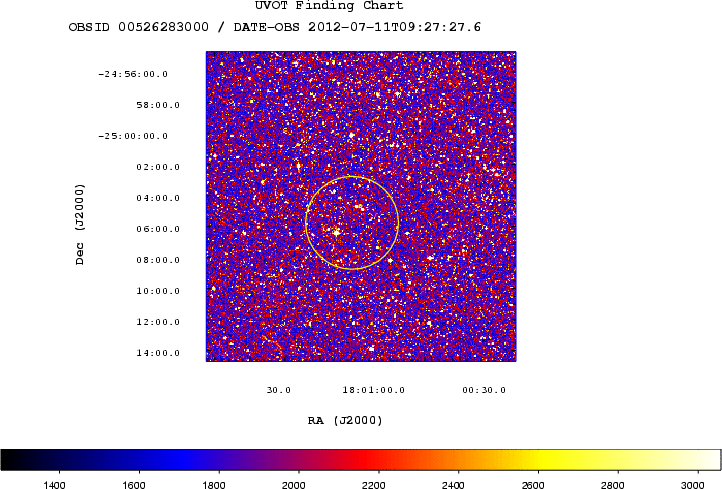
TITLE: GCN/SWIFT NOTICE
NOTICE_DATE: Wed 11 Jul 12 09:33:10 UT
NOTICE_TYPE: Swift-UVOT Image
TRIGGER_NUM: 526283, Seg_Num: 0
POINT_RA: 270.298d {+18h 01m 11s} (J2000)
POINT_DEC: -25.100d {-25d 05' 58"} (J2000)
ROLL: 265.136d
IMG_START_DATE: 16119 TJD; 193 DOY; 12/07/11
IMG_START_TIME: 34038.18 SOD {09:27:18.18} UT, 495.6 [sec] since BAT Trigger Time
FILTER: 10, White
EXPOSURE_ID: 363691647
X_OFFSET: 943 [pixels]
Y_OFFSET: 986 [pixels]
WIDTH: 160 [pixels]
HEIGHT: 160 [pixels]
X_GRB_POS: 1103
Y_GRB_POS: 1146
BINNING_INDEX: 1
IM_URL: sw00526283000msuni0505.fits
SUN_POSTN: 111.08d {+07h 24m 20s} +22.02d {+22d 01' 21"}
SUN_DIST: 160.89 [deg] Sun_angle= -10.6 [hr] (East of Sun)
MOON_POSTN: 20.12d {+01h 20m 29s} +12.19d {+12d 11' 22"}
MOON_DIST: 112.77 [deg]
MOON_ILLUM: 47 [%]
GAL_COORDS: 5.07, -1.04 [deg] galactic lon,lat of the pointing direction
ECL_COORDS: 270.27, -1.66 [deg] ecliptic lon,lat of the pointing direction
COMMENTS: SWIFT-UVOT Image.
COMMENTS: The GRB Position came from the XRT Position Command.
COMMENTS: The image has 2x2 binning (compression).
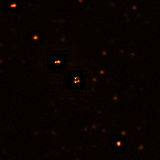
TITLE: GCN/SWIFT NOTICE
NOTICE_DATE: Wed 11 Jul 12 09:33:28 UT
NOTICE_TYPE: Swift-UVOT Processed Image
TRIGGER_NUM: 526283, Seg_Num: 0
POINT_RA: 270.298d {+18h 01m 11s} (J2000)
POINT_DEC: -25.100d {-25d 05' 58"} (J2000)
ROLL: 265.136d
IMG_START_DATE: 16119 TJD; 193 DOY; 12/07/11
IMG_START_TIME: 34038.18 SOD {09:27:18.18} UT, 495.6 [sec] since BAT Trigger Time
FILTER: 10, White
EXPOSURE_ID: 363691647
X_OFFSET: 943 [pixels]
Y_OFFSET: 986 [pixels]
WIDTH: 160 [pixels]
HEIGHT: 160 [pixels]
X_GRB_POS: 1103
Y_GRB_POS: 1146
BINNING_INDEX: 1
IM_URL: sw00526283000msuni0505.fits
SUN_POSTN: 111.08d {+07h 24m 20s} +22.02d {+22d 01' 21"}
SUN_DIST: 160.89 [deg] Sun_angle= -10.6 [hr] (East of Sun)
MOON_POSTN: 20.13d {+01h 20m 30s} +12.19d {+12d 11' 25"}
MOON_DIST: 112.77 [deg]
MOON_ILLUM: 47 [%]
GAL_COORDS: 5.07, -1.04 [deg] galactic lon,lat of the pointing direction
ECL_COORDS: 270.27, -1.66 [deg] ecliptic lon,lat of the pointing direction
COMMENTS: SWIFT-UVOT Processed Image.
COMMENTS: The GRB Position came from the XRT Position Command.
COMMENTS: The image has 2x2 binning (compression).
COMMENTS: All 4 attachments are included.

TITLE: GCN/SWIFT NOTICE
NOTICE_DATE: Wed 11 Jul 12 09:35:57 UT
NOTICE_TYPE: Swift-UVOT Source List
TRIGGER_NUM: 526283, Seg_Num: 0
POINT_RA: 270.299d {+18h 01m 12s} (J2000)
POINT_DEC: -25.101d {-25d 06' 01"} (J2000)
POINT_ROLL: 265.135d
IMG_START_DATE: 16119 TJD; 193 DOY; 12/07/11
IMG_START_TIME: 34420.59 SOD {09:33:40.59} UT, 878.0 [sec] since BAT Trigger Time
FILTER: 10, White
BKG_MEAN: 2.448
N_STARS: 190
X_OFFSET: 383 [pixels]
Y_OFFSET: 426 [pixels]
X_MAX: 1822 [pixels]
Y_MAX: 1865 [pixels]
DET_THRESH: 13
PHOTO_THRESH: 7
SL_URL: sw00526283000msufc0878.fits
SUN_POSTN: 111.09d {+07h 24m 21s} +22.02d {+22d 01' 20"}
SUN_DIST: 160.89 [deg] Sun_angle= -10.6 [hr] (East of Sun)
MOON_POSTN: 20.15d {+01h 20m 35s} +12.20d {+12d 11' 48"}
MOON_DIST: 112.79 [deg]
MOON_ILLUM: 47 [%]
GAL_COORDS: 5.07, -1.04 [deg] galactic lon,lat of the pointing direction
ECL_COORDS: 270.27, -1.66 [deg] ecliptic lon,lat of the pointing direction
COMMENTS: SWIFT-UVOT Source List.
TITLE: GCN/SWIFT NOTICE
NOTICE_DATE: Wed 11 Jul 12 09:36:20 UT
NOTICE_TYPE: Swift-UVOT Processed Source List
TRIGGER_NUM: 526283, Seg_Num: 0
POINT_RA: 270.299d {+18h 01m 12s} (J2000)
POINT_DEC: -25.101d {-25d 06' 01"} (J2000)
POINT_ROLL: 265.135d
IMG_START_DATE: 16119 TJD; 193 DOY; 12/07/11
IMG_START_TIME: 34420.59 SOD {09:33:40.59} UT, 878.0 [sec] since BAT Trigger Time
FILTER: 10, White
BKG_MEAN: 2.448
N_STARS: 190
X_OFFSET: 383 [pixels]
Y_OFFSET: 426 [pixels]
X_MAX: 1822 [pixels]
Y_MAX: 1865 [pixels]
DET_THRESH: 13
PHOTO_THRESH: 7
SL_URL: sw00526283000msufc0878.fits
SUN_POSTN: 111.09d {+07h 24m 21s} +22.02d {+22d 01' 20"}
SUN_DIST: 160.89 [deg] Sun_angle= -10.6 [hr] (East of Sun)
MOON_POSTN: 20.15d {+01h 20m 36s} +12.20d {+12d 11' 52"}
MOON_DIST: 112.79 [deg]
MOON_ILLUM: 47 [%]
GAL_COORDS: 5.07, -1.04 [deg] galactic lon,lat of the pointing direction
ECL_COORDS: 270.27, -1.66 [deg] ecliptic lon,lat of the pointing direction
COMMENTS: SWIFT-UVOT Processed Source List.
COMMENTS: All 4 attachments are included.
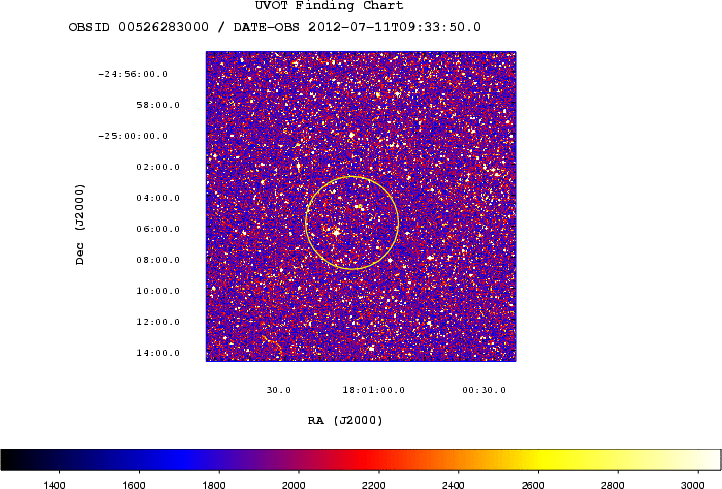
TITLE: GCN/SWIFT NOTICE
NOTICE_DATE: Wed 11 Jul 12 09:37:26 UT
NOTICE_TYPE: Swift-UVOT Image
TRIGGER_NUM: 526283, Seg_Num: 0
POINT_RA: 270.299d {+18h 01m 12s} (J2000)
POINT_DEC: -25.101d {-25d 06' 01"} (J2000)
ROLL: 265.135d
IMG_START_DATE: 16119 TJD; 193 DOY; 12/07/11
IMG_START_TIME: 34420.59 SOD {09:33:40.59} UT, 878.0 [sec] since BAT Trigger Time
FILTER: 10, White
EXPOSURE_ID: 363692030
X_OFFSET: 942 [pixels]
Y_OFFSET: 985 [pixels]
WIDTH: 160 [pixels]
HEIGHT: 160 [pixels]
X_GRB_POS: 1102
Y_GRB_POS: 1145
BINNING_INDEX: 1
IM_URL: sw00526283000msuni0888.fits
SUN_POSTN: 111.09d {+07h 24m 21s} +22.02d {+22d 01' 20"}
SUN_DIST: 160.89 [deg] Sun_angle= -10.6 [hr] (East of Sun)
MOON_POSTN: 20.16d {+01h 20m 38s} +12.20d {+12d 12' 02"}
MOON_DIST: 112.80 [deg]
MOON_ILLUM: 47 [%]
GAL_COORDS: 5.07, -1.04 [deg] galactic lon,lat of the pointing direction
ECL_COORDS: 270.27, -1.66 [deg] ecliptic lon,lat of the pointing direction
COMMENTS: SWIFT-UVOT Image.
COMMENTS: The GRB Position came from the Window Position in the Mode Command.
COMMENTS: The image has 2x2 binning (compression).
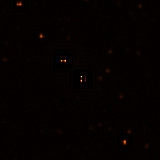
TITLE: GCN/SWIFT NOTICE
NOTICE_DATE: Wed 11 Jul 12 09:37:44 UT
NOTICE_TYPE: Swift-UVOT Processed Image
TRIGGER_NUM: 526283, Seg_Num: 0
POINT_RA: 270.299d {+18h 01m 12s} (J2000)
POINT_DEC: -25.101d {-25d 06' 01"} (J2000)
ROLL: 265.135d
IMG_START_DATE: 16119 TJD; 193 DOY; 12/07/11
IMG_START_TIME: 34420.59 SOD {09:33:40.59} UT, 878.0 [sec] since BAT Trigger Time
FILTER: 10, White
EXPOSURE_ID: 363692030
X_OFFSET: 942 [pixels]
Y_OFFSET: 985 [pixels]
WIDTH: 160 [pixels]
HEIGHT: 160 [pixels]
X_GRB_POS: 1102
Y_GRB_POS: 1145
BINNING_INDEX: 1
IM_URL: sw00526283000msuni0888.fits
SUN_POSTN: 111.09d {+07h 24m 21s} +22.02d {+22d 01' 19"}
SUN_DIST: 160.89 [deg] Sun_angle= -10.6 [hr] (East of Sun)
MOON_POSTN: 20.16d {+01h 20m 38s} +12.20d {+12d 12' 05"}
MOON_DIST: 112.80 [deg]
MOON_ILLUM: 47 [%]
GAL_COORDS: 5.07, -1.04 [deg] galactic lon,lat of the pointing direction
ECL_COORDS: 270.27, -1.66 [deg] ecliptic lon,lat of the pointing direction
COMMENTS: SWIFT-UVOT Processed Image.
COMMENTS: The GRB Position came from the Window Position in the Mode Command.
COMMENTS: The image has 2x2 binning (compression).
COMMENTS: All 4 attachments are included.
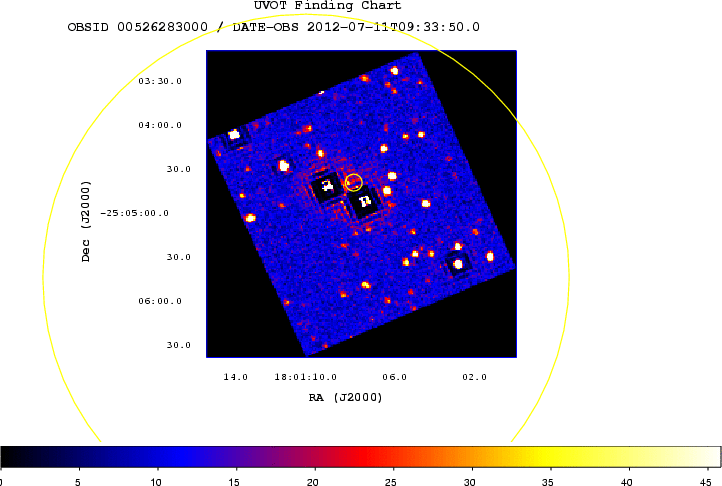
(R.A., Dec) = (+94.86 deg, -70.99 deg) = (06 19 29, -70 59 26)(J2000) (R.A., Dec) = (+94.93 deg, -71.21 deg) = (06 19 44, -71 12 23)(J2000) (R.A., Dec) = (+91.53 deg, -71.22 deg) = (06 06 06, -71 13 27)(J2000) (R.A., Dec) = (+91.52 deg, -71.01 deg) = (06 06 05, -71 00 26)(J2000)This error region includes the position of GRB 120711A reported by Lacluyze et al. (GCN #13430) and Gotz et al. (GCN #13434).
g' = 20.9 +/- 0.1
r' = 20.2 +/- 0.1
i' = 19.6 +/- 0.1
z' = 19.4 +/- 0.1
J = 18.6 +/- 0.1
H = 18.2 +/- 0.1
K = 18.0 +/- 0.1
The SED, after correction for Galactic reddening along the line of sight
(E(B-V)=0.09 mag; Schlegel et al. 1998), can be described by a power law
(beta ~ 1.4) with a reduced flux in the g-band, suggesting a photometric
redshift of about 3. We note that also the PROMPT afterglow light curve
(http://skynet.unc.edu/grb/grb120711a.png) supports a drop-out in the blue
bands.
RA (J2000): 06h 18m 42.79s Dec(J2000): -70d 59' 56.6"with an uncertainty of 1.7 arcsec (radius, 90% confidence). This position is 29 arcsec from the INTEGRAL position and 0.3 arcsec from the Skynet/PROMPT position (LaCluyze et al. GCN Circ. 13430).
Total column: 2.4 (+0.9, -0.8) x 10^21 cm^-2 Galactic foreground: 7.9 x 10^20 cm^-2 Excess significance: 3.2 sigma Photon index: 1.80 (+0.25, -0.23)The results of the XRT-team automatic analysis are available at http://www.swift.ac.uk/xrt_products/00020223.
Filter T_start(s) T_stop(s) Exp(s) Mag b 8464 8480 16 >18.7 u 8380 8459 79 >19.4 w1 8216 8375 157 >19.8 u 8380 8459 79 19.6 =B1 0.5 (2sig)The magnitudes in the table are not corrected for the Galactic extinction due to the reddening of E(B-V) =3D 0.08 in the direction of the burst (Schlegel et al. 1998).
RA(J2000) = 94.7 deg Dec(J2000) = -70.9 degwith an error radius of 0.16 deg (90% containment, statistical error only), which is 0.09 deg from the XRT position, and 0.07 deg from the position reported by Tam et al. (GCN 13444).